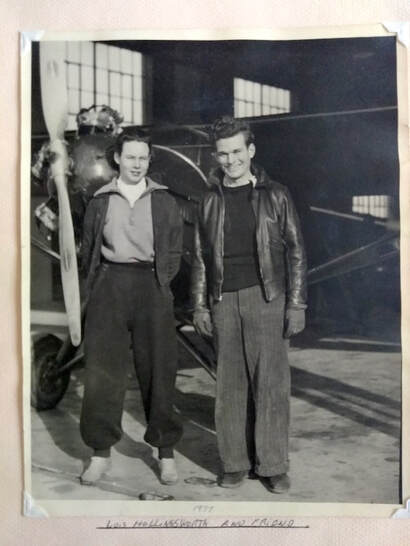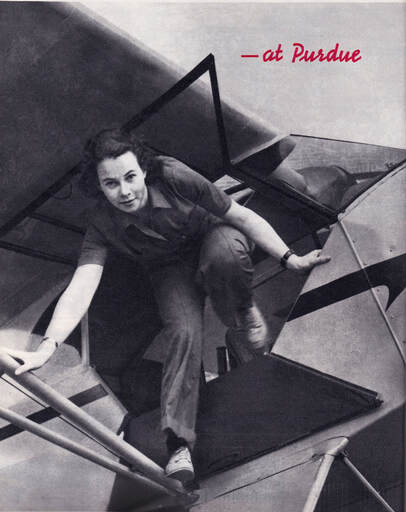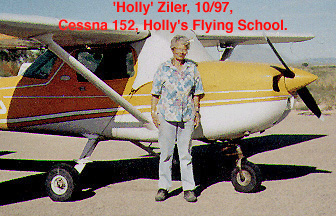WASP, Class 43-3
|
Holly was born in Tulsa, Oklahoma, but grew up in University City, Missouri, on October 14, 1920. She shared her youth with two sisters Romayne and Frances. In May, 1927, Charles Lindbergh made his successful flight across the Atlantic. (On October 4, 2000, at the recent WASP reunion activities sponsored by the Texas Womans University in Denton, Texas, Holly stated during a WASP panel discussion that "it was Lindy" that inspired her to take flight.) A year later, when she was just 7, Holly was building model airplanes with all the boys. She was known as Little Lindy for several years. At age 11, Holly's parents died after a long illness. She spent the rest of her pre adult life with an older sister and other relatives. By the time she was 14, she had purchased a horse with her baby sitting money and used the fees she collected giving other kids rides to pay for the hay and oats for the horse. When she was 16, she soloed in an open cockpit biplane - a Fleet with a Kinner engine. The following year she obtained her private license. |
During her talk on the TWU WASP Panel, Holly talked about the dates she used to have in college. She and her boyfriend would ride the trolley from one end of the line to the other. When the trolley reached the end of the line, the conductor would have to stop and reverse the power connections to go back the other direction. When he did, the lights would go out. He took his time and as Holly said, "that's when we got busy" for a couple of minutes anyway.
Is he the boyfriend mentioned above? Photo from 1937.
(Added 2021)
He was searching from the name on the photo and offered the photo for sharing.
This research lead to a November, 1939, issue of The American Magazine, which included this description and photo of Lois.
(Added 2/2023)
WWII was now in progress. There was a U-boat scare on the east coast. All private flying was banned. Holly decided to join the Civil Air Patrol, but they wouldn't let women fly. However, she did get to learn Morse Code and how to drill in the CAP. Little did she know that this training and her flying experience would be helpful when Jacqueline Cochran started organizing an effort to bring women into the war effort to relieve male pilots for overseas duty.
In early 1943, Holly joined what at the time was called the Women's Flying Training Detachment (WFTD). Her class, the third one, 43-3, started with 58 women pilots, including my mother. On July 3, 1943, 38 of these women graduated and were assigned to various ferrying squadrons around the country. In August, 1943, the WFTDs were renamed to Women Airforce Service Pilots (WASPs)
Initially, Holly, and Betty Deuser Budde, reported to Love Field in Dallas Texas, where they were supposed to support the Auxilliary Ferring Command's 5th Ferrying Group. Lois, Betty and several others were only there overnight and were sent to Camp Davis in North Carolina, via Washington, D. C. for three months of tow target training. Then Lois and 14 others went to Liberty Field in Hinesville, Georgia, for three months of radio control targeting training and then on to Biggs Army Air Field in El Paso, Texas, where she put her advanced training to work. While in the WASPs, Holly bought 80 acres of desert east of El Paso, in a new farming community called Dell City, Texas.
After the WASPs were disbanded on December 20, 1944, Holly became a certified flight instructor in El Paso, made a living teaching flying to all the GIs with their GI bill benefits, and eventually married one of her students, Doyle Ziler in 1946. A few years later, she and Doyle moved to Dell City, where they grew cotton and vegetables, raised chickens, cows, and pigs, and three kids - Donnie, Jerry, and Mary. (I got to spend a few summers on the farm earning some money as a farm laborer; hoeing cotton, chasing calves, milking the cow, collecting fresh eggs, building forts with bales of hay, and swiping watermelons while I was supposed to be working.)
While living in Dell City, she also obtained her teaching certificate and taught High School Math. She taught for 18 years.
Holly and Doyle eventually retired from farming and she started Holly's Flying School. Until just recently, she was still teaching flying. In fact, on October 1 of this year she got to fly an ultralight. One of her former students living in California, drove into Dell City, with his ultralight in tow. She got to fly it, but made a rough landing and damaged one of his gas tanks. He was able to fix it later. During her TWU panel discussion, she warned the audience to keep their mouth's shut because of the bugs in the air.
|
I last saw Holly in Midland, Texas, on October 7, 2000. Holly, Doyle, my mother and I, two other WASPs, Emma Coulter Ware, and Betty Deuser Budde. Many other WASPs, and their relatives, were there as guests of the Confederate Air Force for the 2000 WASP Reunion. Little did anyone suspect what would happen before the end of the month. At two in the morning of October 27, 2000, Holly accepted her second pair of wings. Memorial services were held on November 19, 2000. These services celebrated her life. Many voiced their fond remembrances of Holly and what she meant to them. The poem below as well has a letter signed by several of her Confederate Air Force pilot friends were read at the services. |
|
CELESTIAL FLIGHT:
There is no service ceiling.
For she is universal
And understand a pilot's Fate
So all you loved ones, dry your eyes,
by Elizabeth MacKethan Magid, WASP 44-W-2
|















